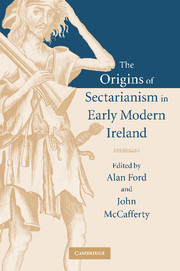Book contents
- Frontmatter
- Contents
- Preface
- List of contributors
- List of abbreviations
- 1 Living together, living apart: sectarianism in early modern Ireland
- 2 Confessionalisation in Ireland: periodisation and character, 1534–1649
- 3 Protestant prelates or godly pastors? The dilemma of the early Stuart episcopate
- 4 ‘In imitation of that holy patron of prelates the blessed St Charles’: episcopal activity in Ireland and the formation of a confessional identity, 1618–1653
- 5 A haven of popery: English Catholic migration to Ireland in the age of plantations
- 6 The Irish historical renaissance and the shaping of Protestant history
- 7 Religion, culture and the bardic elite in early modern Ireland
- 8 The political and religious thought of Florence Conry and Hugh McCaughwell
- 9 Sectarianism: division and dissent in Irish Catholicism
- 10 Purity of blood and purity of faith in early modern Ireland
- 11 Concluding reflection: confronting the violence of the Irish reformations
- Index
8 - The political and religious thought of Florence Conry and Hugh McCaughwell
Published online by Cambridge University Press: 24 November 2009
- Frontmatter
- Contents
- Preface
- List of contributors
- List of abbreviations
- 1 Living together, living apart: sectarianism in early modern Ireland
- 2 Confessionalisation in Ireland: periodisation and character, 1534–1649
- 3 Protestant prelates or godly pastors? The dilemma of the early Stuart episcopate
- 4 ‘In imitation of that holy patron of prelates the blessed St Charles’: episcopal activity in Ireland and the formation of a confessional identity, 1618–1653
- 5 A haven of popery: English Catholic migration to Ireland in the age of plantations
- 6 The Irish historical renaissance and the shaping of Protestant history
- 7 Religion, culture and the bardic elite in early modern Ireland
- 8 The political and religious thought of Florence Conry and Hugh McCaughwell
- 9 Sectarianism: division and dissent in Irish Catholicism
- 10 Purity of blood and purity of faith in early modern Ireland
- 11 Concluding reflection: confronting the violence of the Irish reformations
- Index
Summary
One of the striking features of Irish life in the first years of the seventeenth century was the speed with which both the Gaelic literati and the Catholic hierarchy accepted James I as the legitimate monarch of Ireland. Before granting recognition to James, however, the Catholic authorities had one major difficulty to overcome. After all, the peculiarities of the Irish scene with a Protestant monarch ruling over a Catholic people, was a complete contradiction of the solution proposed in Augsburg in 1555, cuius regio eius religio. If James was the de facto monarch, what were the obligations of his Catholic subjects vis-à-vis what was a heretical monarch according to the Catholic church?
The question was further complicated by James' own background. His mother, Mary Queen of Scots, was a Catholic. His wife, Anne of Denmark, had converted to Catholicism shortly before her husband's proclamation as king of England. There were even rumours, both at home and abroad, that James himself was about to become a Catholic, rumours that he did little to dispel, even if they had no basis in fact. English recusants were under the impression that James' accession to the throne of England would herald a new era of tolerance for Catholics. It is difficult to know exactly what promises James made during the negotiations prior to his succession and Antonia Fraser has drawn attention to his superb diplomatic skills in raising religious hopes without actually satisfying them.
- Type
- Chapter
- Information
- The Origins of Sectarianism in Early Modern Ireland , pp. 183 - 202Publisher: Cambridge University PressPrint publication year: 2005
- 1
- Cited by

